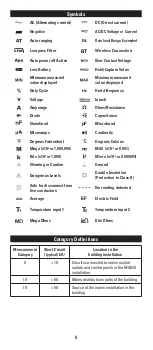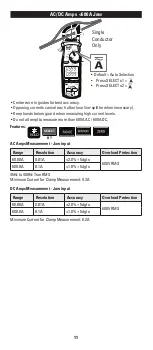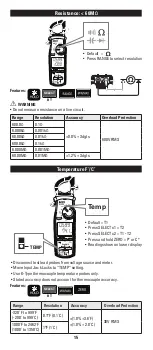
19
Test Lead Notes
Cat IV and CAT II Measurement Locations
• Ensure the test lead shield is pressed firmly in place. Failure to use the CAT
IV shield increases arc-flash risk.
CAT II Measurement Locations
• CAT IV shields may be removed for CAT II locations. This will allow testing
on recessed conductors such as standard wall outlets. Take care not to lose
the shields.
WARNING:
Test Lead category protections apply only to test leads and
should not be confused with the meter’s specific CAT rating. Observe the
maximum category protection indicated on the meter the test leads are
plugged into.
CAUTION
: If the test leads need to be replaced, you must use a new one
which should meet EN 61010-031 standard, rated CATIII 1000V or better.
NOTE:
DL599 works with UEi ATL58 test leads, ABP3 back probes and AAC3
alligator clips.
ABP3 Back Probes screw-on to test leads, after removing CATIV shields from
test leads. Back Probes come with covers on probe tips.
4mm
18mm
4mm
18mm
FCC INFORMATION
NOTE:
This equipment has been tested and found to comply with the limits
for a Class B digital device, pursuant to part 15 of the FCC rules. These limits
are designed to provide reasonable protection against harmful interference
in a residential installation.
This equipment generates, uses and can radiate radio frequency energy and,
if not installed and used in accordance with instructions, may cause harmful
interference to radio communications. However, there is no guarantee that
interference will not occur in any particular installation. If this equipment
does cause harmful interference to radio or television reception, which can
be determined by turning the equipment on and off, the user is encouraged
to try and correct the interference by one or more of the following measures:
• Reorient or relocate the receiving antenna.
• Increase the separation between the equipment and receiver.
• Connect the equipment into an outlet on a circuit different from that to
which the receiver is connected.
• Consult the dealer or an experienced radio/TV technician for help.
CAUTION
Changes or modifications not expressly approved by the
manufacturer responsible for compliance could void the user’s authority to
operate the equipment.
(1) this device may not cause interference, and
(2) this device must accept any interference, including interference that may
cause undesired operation of the device.
















